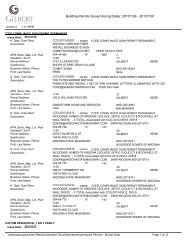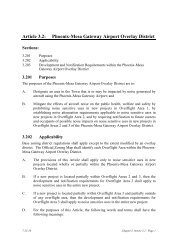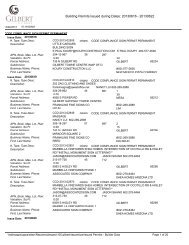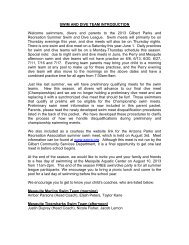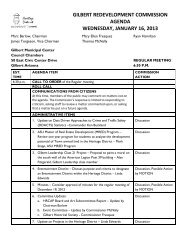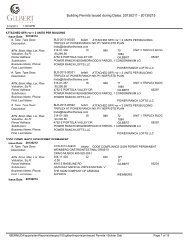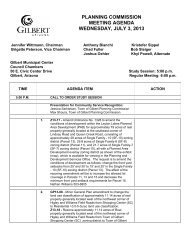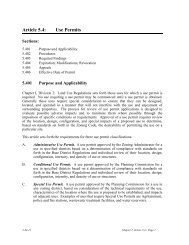Water Quality Data - Town of Gilbert
Water Quality Data - Town of Gilbert
Water Quality Data - Town of Gilbert
You also want an ePaper? Increase the reach of your titles
YUMPU automatically turns print PDFs into web optimized ePapers that Google loves.
<strong>Town</strong> <strong>of</strong> <strong>Gilbert</strong>, Public Works <strong>Gilbert</strong>, Arizona<br />
2012 <strong>Water</strong> <strong>Quality</strong> Report<br />
<strong>Town</strong> <strong>of</strong> <strong>Gilbert</strong><br />
50 E. Civic Center Drive<br />
<strong>Gilbert</strong>, AZ 85296<br />
Learn more about<br />
your <strong>Water</strong> <strong>Quality</strong><br />
http://www.gilbertaz.gov/<br />
pw/water-quality.cfm<br />
Eye to Eye<br />
to Supervise<br />
www.gilbertaz.gov/<br />
<strong>Water</strong>Safety<br />
SOURCE WATER ASSESSMENT<br />
In 2004, ADEQ completed a Source <strong>Water</strong> Assessment (SWA) for the 12 groundwater wells (at the time <strong>of</strong> the assessment) and one WTP used by the <strong>Town</strong> <strong>of</strong> <strong>Gilbert</strong>. The assessment<br />
reviewed and evaluated adjacent land uses to the aforementioned locations that may pose a potential risk to water, and the quality there<strong>of</strong>, served to the community from those<br />
sources. These risks may include, but are not limited to, gas stations, landfills, dry cleaners, and agriculture fields.<br />
The result <strong>of</strong> the SWA led to 10 sources receiving a low risk susceptibility to water rating and three identified as high risk. Those sites receiving a high risk designation are located<br />
in proximity to a gas station, agriculture field, and an industrial park. None <strong>of</strong> the locations, including those with a low risk assessment, have detected contamination; however, the<br />
<strong>Town</strong> remains vigilant in their monitoring to ensure the best water quality is served to our community. Residents can help protect source water by taking hazardous household<br />
chemicals to hazardous material collection sites (www.gilbertaz.gov/pw/hhw.cfm) and by limiting the amount <strong>of</strong> pesticide and fertilizer use in the home.<br />
The SWA is available to the public by request from the <strong>Town</strong> <strong>of</strong> <strong>Gilbert</strong> Clerk’s Office or visit the ADEQ’s SWA Unit website at www.azdeq.gov/environ/water/dw/swap.html for an<br />
electronic copy.<br />
DRINKING WATER - POSSIBLE CONTAMINATION SOURCES<br />
Drinking water, including bottled water, may reasonably be expected to contain at least small amounts <strong>of</strong> some contaminants. In order to ensure that tap water is safe to drink, the<br />
U.S. EPA and the State <strong>of</strong> Arizona prescribe regulations that limit the amount <strong>of</strong> certain contaminants in the water provided by public water systems as drinking water. The presence<br />
<strong>of</strong> contaminants does not necessarily indicate that water poses a health risk. More information about contaminants in tap water and potential health effects can be obtained by<br />
calling the EPA Safe Drinking <strong>Water</strong> Hotline at 800/426-4791. Information on bottled water can be obtained from the U.S. Food and Drug Administration (FDA).<br />
As water travels over the surface <strong>of</strong> the land or through the ground it dissolves naturally occurring minerals and can pick up substances resulting from the presence <strong>of</strong> animals or<br />
from human activity. Contaminants that may be present in source water include:<br />
Inorganic contaminants include salts and metals that can be naturally occurring in the makeup <strong>of</strong> soil and run<strong>of</strong>f from erosion. In addition, nitrate is found in fertilizer and<br />
animal waste products.<br />
Microbial contaminants include viruses or bacteria that may come from agricultural livestock operations or wildlife.<br />
Organic chemical contaminants include synthetic and volatile organic chemicals that are by-products <strong>of</strong> industrial processes and petroleum production that may come from<br />
places such as gas stations and urban stormwater run<strong>of</strong>f.<br />
Disinfection byproducts, precursors, turbidity, and biological species are naturally occurring in the makeup <strong>of</strong> soil, run<strong>of</strong>f from erosion, and are byproducts <strong>of</strong> human and<br />
animal wastes. These analyses and species are tested in the WTP filtration process, in the distribution system, and at source water points <strong>of</strong> entry into the distribution system to<br />
ensure the effectiveness <strong>of</strong> water treatment and proper disinfection.<br />
Pesticide and herbicide contaminants may come from agriculture, urban stormwater run<strong>of</strong>f, and residential use.<br />
Radioactive contaminants may be naturally occurring or can be the result <strong>of</strong> oil/gas production and mining activities.<br />
Turbidity is a measure <strong>of</strong> the cloudiness <strong>of</strong> the water. It is measured because it is a good indicator <strong>of</strong> water quality, and high levels <strong>of</strong> turbidity can hinder the effectiveness <strong>of</strong><br />
the disinfection process.<br />
* Some people may be more vulnerable to contaminants in drinking water than the general population. Immuno compromised persons such a persons with cancer undergoing chemotherapy; persons who have<br />
undergone organ transplants; persons with HIV, AIDS, or other immune system disorders; some elderly; and infants can be particularly at risk from infections. These people should seek advice about drinking water<br />
from their health care providers. The U.S. EPA and the Center for Disease Control (CDC) guidelines on appropriate means to lessen the risk <strong>of</strong> infection by Cryptosporidium and other microbial contaminants are<br />
available from the Safe Drinking <strong>Water</strong> Hotline at 800/426-4971.<br />
18
elev.<br />
1209<br />
5<br />
(G)<br />
15<br />
16<br />
(G)<br />
7<br />
.<br />
intertie<br />
w/ Chandler<br />
elev.<br />
1281<br />
18<br />
elev.<br />
1341<br />
Baseline Rd.<br />
(G)<br />
23<br />
26<br />
bi-direction<br />
zone<br />
8 boosters<br />
12<br />
NWTP<br />
Guadalupe<br />
24” (G) 36” (G)<br />
Rd.<br />
fill for 25<br />
14<br />
17<br />
Well<br />
Elliot Rd.<br />
4<br />
(G)<br />
3<br />
Warner Rd.<br />
F1<br />
Santan<br />
Fwy.<br />
Res Well<br />
Ray Rd.<br />
Lindsay (G)<br />
Road<br />
elev.<br />
Res.<br />
24<br />
1325<br />
(G)<br />
Wms. Field<br />
Rd.<br />
Cooley St<br />
19<br />
PecosRd.<br />
(G)<br />
29<br />
SPRR<br />
Germann Rd.<br />
30<br />
Res. 20<br />
(G)<br />
Queen Creek<br />
22 Well 20 Rd.<br />
elev.<br />
1264<br />
Bridges/<br />
intertie<br />
Layton<br />
Well CAP w/ Q.C.<br />
Lakes<br />
48”<br />
Ocotillo Rd.<br />
Freeman Farm 27<br />
Bi-Dir/booster (G)<br />
SVWTP<br />
Chandler<br />
Well 21 Hgts. Rd.<br />
28<br />
(G) (G)<br />
.<br />
Res. 21<br />
Riggs Rd.<br />
Adora<br />
Trail<br />
elev.<br />
1421<br />
F8<br />
Hunt Hwy.<br />
elev.<br />
1293<br />
.<br />
.<br />
24”<br />
.<br />
.<br />
30”<br />
.<br />
SPRR<br />
Consolidated<br />
Canal<br />
Eastern<br />
Canal<br />
RWCD Canal<br />
25<br />
.<br />
SRP<br />
CAP<br />
<strong>Town</strong> <strong>of</strong> <strong>Gilbert</strong><br />
<strong>Water</strong> System Map<br />
Pay your utility bills online. Sign up for paperless billing at<br />
http://www.gilbertaz.gov/utilities<br />
Welcome<br />
Dear <strong>Water</strong> Customer,<br />
Welcome and thank you for choosing the <strong>Town</strong> <strong>of</strong> <strong>Gilbert</strong> for your residence. We are pleased to report another successful year providing<br />
our customers with tap water that met and/or exceeded the federal and state standards.<br />
Following is the <strong>Water</strong> <strong>Quality</strong> Report, also known as the Consumer Confidence Report (CCR) for the water quality data for the year<br />
2011. The CCR is our report with a summary <strong>of</strong> water quality data, water supply and other useful information.<br />
The Safe Drinking <strong>Water</strong> Act <strong>of</strong> 1974 and subsequent amendments by the U.S. Environmental Protection Agency (EPA) dictate that<br />
water providers monitor their treatment processes and systems to ensure a safe drinking water supply. The <strong>Town</strong> uses guidance from<br />
the U.S. EPA, the Arizona Department <strong>of</strong> Environmental <strong>Quality</strong> (ADEQ), and the Maricopa County Environmental Health Services (MCEHS)<br />
to establish regular monitoring schedules for contaminants such as organic and inorganic chemicals as well as microbiological species.<br />
<strong>Water</strong> <strong>Quality</strong> <strong>Data</strong><br />
We routinely monitor for contaminants in your drinking water according to Federal and State laws. The State <strong>of</strong> Arizona requires us to monitor for certain contaminants less than<br />
once per year because the concentrations <strong>of</strong> these contaminants are not expected to vary significantly from year to year, or the system is not considered vulnerable to this type <strong>of</strong><br />
contamination. Some <strong>of</strong> our data, though representative, may be more than one year old.<br />
Microbiological Contaminants<br />
Contaminant MCL MCLG Units Result<br />
Total Coliform Bacteria for Systems<br />
that collects > 40 samples per month<br />
Fecal Coliform and E. Coli<br />
No more than 5% <strong>of</strong> monthly<br />
samples can be positive<br />
A routine sample & a repeat<br />
sample are total coliform<br />
positive, & one is also fecal<br />
coliform or E. coli positive<br />
Absent or<br />
0 0.6%<br />
Present<br />
Absent or<br />
0 0%<br />
Present<br />
Turbidity<br />
TT Requirement Level Found Sample Date<br />
Maximum 1 NTU for any single<br />
measurement<br />
In any month, at least 95% <strong>of</strong> samples<br />
must be less than 0.3 NTU<br />
Disinfectants<br />
Highest single measurement: 0.21 NTU Date: 1/27<br />
Lowest monthly percentage <strong>of</strong><br />
samples meeting TT standard for our<br />
technology: 100 % <strong>of</strong> monthly<br />
measurements were less than 0.3 NTU<br />
N/A<br />
MRDL MRDLG Units Detected Level Range<br />
Chlorine 4 4 ppm 0.22-3.20<br />
Disinfection Byproducts<br />
Contaminant<br />
MCL MCLG Units Average Range<br />
Haloacetic Acids (HAA) 60 N/A ppb 16.1 ND-51<br />
Total Trihalomethanes (TTHM) 80 N/A ppb 43.9 ND-97<br />
Bromate 10 0 ppb 0.00079 ND-9.6<br />
Total Organic Carbon<br />
Contaminant<br />
Compliance Factor<br />
(measurements should not<br />
be lower than this factor)<br />
Lowest Running<br />
Annual Average<br />
(compliance factor)<br />
Running Annual<br />
Average Range<br />
for theYear<br />
(compliance factor)<br />
Total Organic Carbon<br />
(TOC) Removal Ratio<br />
1.0 1.3 1.00-1.70<br />
Unregulated Contaminant Monitoring<br />
Contaminant<br />
Units Detected Level Range<br />
Hexavalent Chromium<br />
These tables show the results <strong>of</strong> our monitoring for the period <strong>of</strong> January 1 to December 31, 2011 unless otherwise noted.<br />
µg/L<br />
ND-23<br />
Detected Contaminants<br />
Contaminant MCL Units Level Detected/Range<br />
Adjusted Gross Alpha 15 pCi/L ND-3.2 0.9<br />
Arsenic 10 ppb ND-11<br />
Barium 2 ppm 0.0032-0.12<br />
Boron N/A<br />
ppm ND-0.43<br />
Calcium<br />
N/A<br />
ppm 16-120<br />
Chromium 100<br />
ppb ND-18<br />
Combined Uranium 30 µg/L ND-3.9 0.9<br />
Dalapon 0.2<br />
ppm ND-0.0014<br />
Fluoride 4 ppm ND-0.86<br />
Magnesium N/A<br />
ppm 26-27<br />
Nickel N/A<br />
ppm ND-0.0055<br />
Nitrate (as Nitrogen) 10 ppm ND-9.6<br />
Selenium 50 ppb 2.1-7<br />
Secondary Contaminants<br />
40-430<br />
RAA<br />
1.4 0.6<br />
5.0<br />
0.062<br />
0.10<br />
56<br />
6.0<br />
1.4 0.6<br />
0.00033<br />
0.43<br />
27<br />
0.0024<br />
Contaminant Units Level Detected/Range<br />
Alkalinity ppm 42-196<br />
Aluminum ppm ND-0.35<br />
Hardness as CaCO 3 ppm | gr/gal* 39-290 | 2.3-17<br />
Iron ppm ND-0.09<br />
Temperature °C 14.4-31.4<br />
pH s.u.** 7.55-8.7<br />
Chloride<br />
Langlier Index<br />
Sodium<br />
Sulfate<br />
Total Dissolved Solids<br />
ppm<br />
N/A<br />
ppm<br />
-0.36-0.63<br />
39-260<br />
350-970<br />
*The standard measure for hardness as calcium carbonate (CaCO3) is either gr/gal (grains per gallon) or ppm. 1 gr/gal<br />
<strong>of</strong> hardness is equivalent to 17.1 ppm <strong>of</strong> hardness. **The standard measure for pH is standard units (s.u.).<br />
Lead and Copper<br />
Contaminant<br />
AL<br />
ALG<br />
Units<br />
ppm<br />
ppm<br />
90th<br />
Percentile<br />
Keep Your Kids<br />
in Sight<br />
or<br />
You will be<br />
in for a Fright<br />
Number<br />
<strong>of</strong> Sites<br />
over AL<br />
46-260<br />
3.2<br />
0.12<br />
Violation<br />
(Yes or No)<br />
Copper 1.3 1.3 ppm 0.23 0 No<br />
The Canal’s<br />
not a Pool<br />
Lead 15 0 ppb 1.9 0 No<br />
Santan Vista LT2 Surface <strong>Water</strong> Treatment Rule Monitoring<br />
Contaminant<br />
Units Detected Level Range<br />
Cryptosporidium<br />
oocysts/L<br />
ND<br />
Giardia oocysts/L ND<br />
Health Effects Information About the Above Tables<br />
Nitrate in drinking water at levels above 10 ppm is a health risk for infants <strong>of</strong> less than six months <strong>of</strong> age. High nitrate levels in drinking water can cause blue baby syndrome.<br />
Nitrate levels may rise quickly for short periods-<strong>of</strong>-time because <strong>of</strong> rainfall or agricultural activity. If you are caring for an infant, and detected nitrate levels are above 5 ppm,<br />
you should ask advice from your health care provider.<br />
If arsenic is less than or equal to the MCL, your drinking water meets EPA’s standards. Compliance with MCL is determined by a RAA at any sampling point. EPA’s standard balances<br />
the current understanding <strong>of</strong> arsenic’s possible health effects against the costs <strong>of</strong> removing arsenic from drinking water. EPA continues to research the health effects <strong>of</strong> low levels<br />
<strong>of</strong> arsenic, which is a mineral known to cause cancer in humans at high concentrations and is linked to other health effects such as skin damage and circulatory problems.<br />
Lead and Copper monitoring: In 2010, the <strong>Town</strong> <strong>of</strong> <strong>Gilbert</strong> did triennial monitoring for lead and copper. Lead enters drinking water primarily as a result <strong>of</strong> the corrosion,<br />
or wearing away <strong>of</strong> materials containing lead in the distribution system and household plumbing. EPA requires water suppliers to sample for lead and copper from the cold<br />
water taps inside homes. We tested 54 households and pleased to report that all sites are below federal drinking water action level for lead and copper. To reduce exposure to<br />
lead in drinking water, flush your tap for 30 seconds to 2 minutes before using tap water. Do not cook with or drink water from the hot water tap. Infants and young children are<br />
typically more vulnerable to lead in drinking water than the general population. It is possible that lead levels at your home may be higher than at other homes in the community<br />
as a result <strong>of</strong> materials used in your home’s plumbing. If you are concerned about elevated lead levels in your home’s water, you may wish to have your water tested. Additional<br />
information is available from the EPA Safe Drinking <strong>Water</strong> Hotline at 1-800-426-4791.<br />
Hexavalent Chromium: A report released by the Environmental Working Group in late December 2010 and EPA's interest in looking specifically at hexavalent chromium; <strong>Town</strong> <strong>of</strong><br />
<strong>Gilbert</strong> voluntarily collected samples <strong>of</strong> its raw and finished water at two treatment plants and all the wells. The results <strong>of</strong> these samples are in the above table. EPA has a drinking<br />
water standard <strong>of</strong> 0.1 mg/L (100 ug/L) for total chromium, which includes all forms <strong>of</strong> chromium. There is no specific standard for hexavalent chromium.<br />
Fluoride Levels: Fluoride was not added at the NWTP during the year 2011.<br />
Cryptosporidium and Giardia: At the San tan Vista plant we conducted Cryptosporidium and Giardia sampling for 24 months; January, 2010 – December, 2011. Based on the test<br />
data Maricopa county has classifeid the plant into Bin 1. This means no additional treatment is required.<br />
Definitions<br />
AL(G) = Action Level (Goal) - the concentration <strong>of</strong> a contaminant which, if exceeded, triggers treatment or other requirements.<br />
MCL = Maximum Contaminant Level - The “Maximum Allowed” is the highest level <strong>of</strong> a contaminant that is allowed in drinking water.<br />
MCLG = Maximum Contaminant Level Goal - The “Goal” is the level <strong>of</strong> a contaminant in drinking water below which there is no known or expected risk to health.<br />
MRDL(G)= Maximum Residual Disinfectant Level (Goal)<br />
RAA = Running annual average.<br />
NA = Not Applicable, sampling was not completed by regulation or was not required.<br />
NTU = Nephelometric Turbidity Units, a measure <strong>of</strong> water clarity.<br />
PPM = Parts per million or Milligrams per liter (mg/L).<br />
PPB = Parts per billion or Micrograms per liter (µg/L).<br />
TT = Treatment Technique - A treatment technique is a required process intended to reduce the level <strong>of</strong> a contaminant in drinking water.<br />
Oocyst = a phase or form <strong>of</strong> the organism produced as a normal part <strong>of</strong> the life cycle <strong>of</strong> the organism.<br />
pCi/L = Picocuries per liter is a measure <strong>of</strong> the radioactivity in water.<br />
ND = Non Detect<br />
*Este informe contiene información muy importante sobre su agua potable. Si desea una copia de este informe en español o tiene alguna pregunta sobre el,<br />
por favor llame a 480-503-6383.




